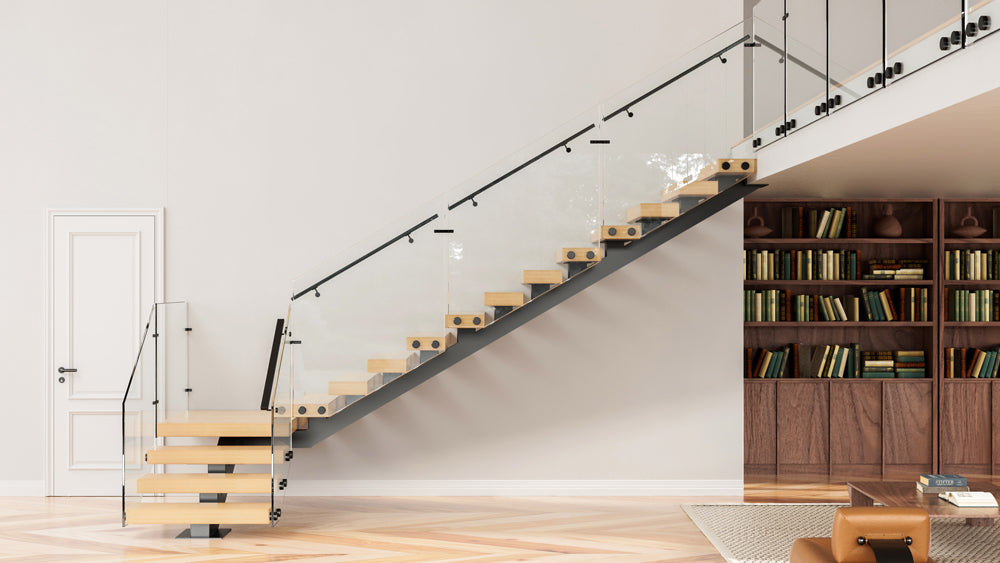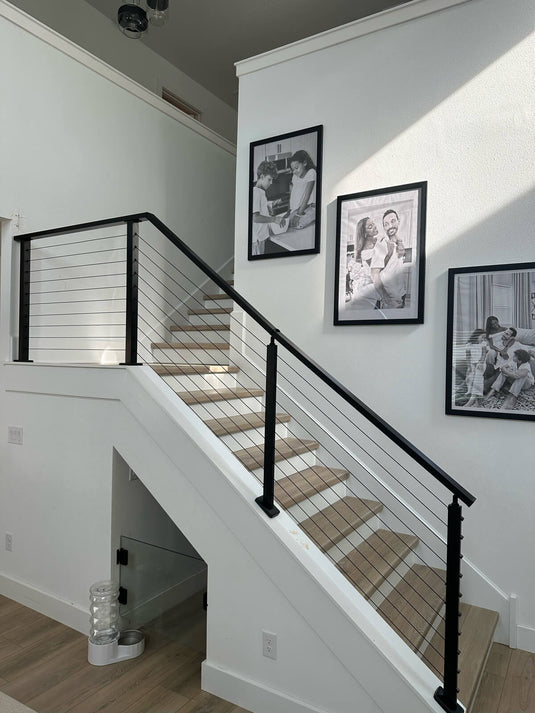TABLE OF CONTENTS
Are Floating Stairs Safe?
Worried about the safety of floating stairs?
You’re not alone—but the truth is,
they are absolutely safe when properly designed and installed!
In fact, floating stairs combine cutting-edge design with rock-solid engineering to create a staircase that’s as reliable as it is beautiful. Keep reading—we’ll show you everything you need to know to build with confidence and style:
● What Makes Floating Stairs Safe? Key Factors and Design Elements
● What Makes Floating Stairs Dangerous? Addressing Common Safety Concerns
● How to Make Floating Stairs Safer: Practical Tips for the Whole Family
● Floating Stairs vs. Traditional Stairs: A Safety Comparison
What Makes Floating Stairs Safe? Key Factors and Design Elements
Robust Structural Engineering
At the heart of every safe floating staircase is a solid structural system. These stairs are typically supported by concealed steel stringers or reinforced wall mounts, engineered to handle substantial loads—often supporting at least 300 pounds per tread. Custom systems may exceed these values to ensure long-term stability and safety.Professional design and installation by licensed experts ensure that all structural components meet strict safety standards, reducing the risk of failure and ensuring long-term durability.
Compliance with Building Codes
Floating stairs are built to adhere to rigorous building codes that protect against fall hazards and structural weaknesses. Key requirements include:
● Tread depth around 10 inches gives you enough space to place your feet comfortably on each step.
● Riser height between 7 and 7.75 inches makes climbing and descending feel natural and easy.
● Handrail height between 34 and 38 inches offers the right level of support to steady yourself as you move.
If you’d like to explore more details about building code compliance for floating stairs, feel free to check out this article for a deeper dive.
High-Quality Materials
Premium materials are essential for both the aesthetics and safety of floating stairs. Common choices include:
● Treads: Textured hardwood, grooved metal, or composite materials resist slipping.
● Supports: Galvanized steel or aircraft-grade aluminum cores resist corrosion.
● Railings: Laminated glass railings or powder-coated cable railings for impact resistance.
These materials are selected not just for looks but for their ability to withstand heavy daily use and environmental stress.

What Makes Floating Stairs Dangerous? Addressing Common Safety Concerns
Despite their safety when properly designed, floating stairs can raise concerns due to their open, minimalist design. Here’s how to address the most common worries:
Open Risers and Fall Risks
The absence of risers (vertical panels between treads) can make floating stairs feel less secure, especially for families with young children or pets who might slip through gaps.
Solution: Design stairs with gaps smaller than 4 inches, as required by most building codes. Alternatively, add partial risers or discreet safety netting beneath treads to prevent falls while preserving the open aesthetic.
Slippery Surfaces
Materials like polished glass or smooth wood can be slippery, especially in socks or wet conditions.
Solution: Use slip-resistant materials, such as textured wood, or metal with anti-slip coatings. Adhesive anti-slip strips are a cost-effective option that blends with the design.
Lack of Handrails
Some floating stair designs omit handrails to emphasize minimalism, which can pose a risk for elderly users or those with mobility challenges.
Solution: Install a handrail on at least one side, ideally 36 inches high, using materials like glass or stainless steel to maintain the modern look. For open-sided stairs, a guardrail can further enhance safety.
Visibility Issues
The open design and sleek materials of floating stairs can make treads harder to see in low light, increasing the risk of missteps.
Solution: Incorporate LED lighting under treads or along handrails. Motion-sensor lights are a trendy, energy-efficient choice for 2025 homes.

How to Make Floating Stairs Safer: Practical Tips for the Whole Family
Floating stairs can be made exceptionally safe with thoughtful design choices, but for certain groups, including the elderly, toddlers, and pets, stairs can be risky. By implementing simple safety measures, you can reduce these risks and ensure everyone can safely navigate stairs.
For the Elderly: Prioritize Support and Stability
Older adults may face balance or mobility challenges, so safety starts with extra support. Install sturdy handrails on both sides of the stairs to give them a secure grip. Add non-slip treads to prevent slips on smooth surfaces, especially if the steps are glass or metal. Consider integrating bright, motion-activated LED lights to improve visibility—especially helpful at night or in low-light areas.

For Children: Control Access and Soften the Impact
Toddlers and young kids are naturally curious but not always aware of danger. Install baby gates at the top and bottom of floating stairs to keep little explorers safe. You can also soften potential impacts by adding corner padding or foam guards to the stair edges. And don’t forget: always keep stairs clear of toys and clutter to avoid trips and tumbles.

For Pets: Make Every Step Easy and Safe
If you’re wondering “are floating stairs safe for dogs?”—the answer is yes, with the right precautions. Small pets or older animals with joint issues may struggle on floating stairs. You can place a pet ramp near shorter stair runs to give them an alternative. For full staircases, apply anti-slip pads or textured covers so your furry friends have grip. Also, make sure there are no gaps between treads large enough for small paws to slip through—consider partial risers if needed.

For more tips on floating stairs safety, feel free to check out our full safety guide: How to Make Stairs Safer for All Family Members: Elderly, Toddlers, and Pets.
Floating Stairs vs. Traditional Stairs: A Safety Comparison
If you’re still concerned about the safety of floating stairs and can’t decide whether to install one, here’s a comparison between floating stairs and traditional staircases to help you make an informed choice.
| Feature | Floating Stairs | Traditional Stairs |
|---|---|---|
| Design | Open, minimalist, modern | Closed risers, often bulkier |
| Safety Risks | Open risers, potential lack of handrails | Fewer gaps, typically include handrails |
| Stability | Strong if properly engineered | Generally stable, less complex engineering |
| Aesthetic Appeal | High, suits modern/luxury homes | Classic, suits traditional homes |
| Customization | Highly customizable for safety | Limited customization for modern appeal |
📣Floating stairs can be as safe as traditional stairs with proper design and safety features, but they require more planning to address risks like open risers and slipperiness.
Are Floating Stairs Safe?
Floating stairs can be both elegant and secure—especially when built with care and expertise. At Muzata, we focus on delivering safe, modern stair solutions backed by solid engineering and high-quality materials. Our floating stair systems feature sturdy metal stringers, slip-resistant treads, and thoughtful safety add-ons like handrails and lighting, all designed to meet today’s building codes.
Safety doesn’t have to come at the expense of style. Muzata’s floating stairs bring a sleek, contemporary look to your space, while offering the reliability and peace of mind that every homeowner deserves. Whether for a cozy home or a bold architectural project, Muzata helps you build with confidence.
Related Topics
About Floating Stairs
Understanding Code Requirements for Open Stairs
How to Build Floating Stairs: A Step-by-Step Guide
Are Floating Stairs Safe for Dogs?
What To Consider When Choosing A Handrail for the Elderly
How to Make Stairs Safer for All Family Members: Elderly, Toddlers, and Pets




